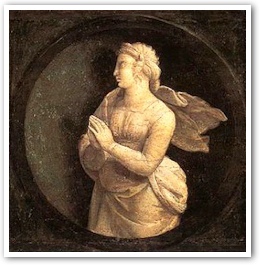Jesus Ascended Into Heaven
- FR. KENNETH BAKER, S.J.
On the top of the Mount of Olives in Jerusalem is situated the small, hexagonal Church of the Ascension which commemorates Jesus final departure from his disciples and from this world (Acts 1:12).
 |
In the Nicene Creed, we profess out belief in Jesus' Ascension when we say: "He ascended into heaven and is seated at the right hand of the Father."
The Ascension is a mystery of faith, just like Jesus' Resurrection, with which it is closely associated. The event is mentioned briefly by the Evangelist Mark (16:19) and Luke (24:50-53). A more detailed account is given by Luke in the Acts of the Apostles (1:1-12).
The Ascension of Jesus can be defined as the transfer of his risen, glorious body to heaven, that is, to the world of the divine. In the Old Testament, God is described in some texts as "descending" from heaven to accomplish something on earth; he then "ascends" or returns to the world of the divine. Jesus himself speaks of descending to this earth and ascending again to the Father once his work of redemption has been accomplished (cf. Jn 3:13, Eph 4:10).
Except for the mention of the forty days by Luke in Acts, Mark, Luke and John think of the Ascension as occurring on the day of the Resurrection. The idea is that the final glorification and exaltation of Jesus takes place at his Resurrection they are two aspects of the same thing. Through his Resurrection-Ascension, he leaves the earth and the created universe to take his place at the right hand of the Father.
This image of sitting "at the right hand of the Father" is influenced by Psalm 110 (1): "The Lord said to my lord: 'Sit at my right hand, till I make your enemies your footstool.'" The image itself comes from the ancient world of kings and courts where the all-powerful king was surrounded by his ministers, with the most powerful and favored one sitting just to the right of the king. Hence, it means in this case that Jesus is one with the Father and shares in his sovereign power over the world and the cosmos.
If Jesus had not entered immediately into his final glory at the Resurrection, it would be difficult to explain where he was during the interim between the Resurrection and the Ascension. We are dealing here with a divine mystery and it is hard for us to grasp the full meaning.
There are enough indications in the Gospel accounts of the appearances of Jesus to support the belief that he was already in the glory of the Father when he appeared to his followers. But there was a period of instruction after the Resurrection during which Jesus gave his Apostles their final preparation before going out to bear witness to him to the ends of the earth. So it is commonly held that the Ascension means the final appearance of Jesus to his Apostles before his definitive departure for heaven. Thus the Ascension has a pedagogical character.
The number "forty" in Scripture means a full period of time, a rounded-out period; it does not necessarily mean literally forty calendar days. In this context, then, it means that Jesus appeared to his disciples regularly for a period and then left them permanently. From then on they had to live by faith and communicate with him through prayer and the sacraments.
Thus, this mystery has two aspects: 1)the heavenly glorification of Christ which coincided with his Resurrection, and 2) his final departure from his Apostles after a period of apparitions. The feast of the Ascension commemorates this second aspect.
The Ascension means that Jesus, triumphant over death, has begun a new life with God. He has gone to heaven to prepare a place for the elect. On the Last Day, he will return to lead them there so that they might take up their abode with him (Jn 14:2 ff.). For this reason, the Ascension is a source of great hope and consolation for Christians.
See the index of chapters from Fundamentals of Catholicism which have been reprinted to CERC here.
 This is Meaghen Gonzalez, Editor of CERC. I hope you appreciated this piece. We curate these articles especially for believers like you.
This is Meaghen Gonzalez, Editor of CERC. I hope you appreciated this piece. We curate these articles especially for believers like you.
Please show your appreciation by making a $3 donation. CERC is entirely reader supported.

Acknowledgement
Kenneth Baker, S.J. "Jesus Ascended Into Heaven." In Fundamentals of Catholicism Vol. 1 Chapter 25 (San Francisco: Ignatius Press, 1995), 77-79.
This article reprinted with permission from Father Kenneth Baker, S.J.
The Author

 Father Kenneth Baker, S.J., assumed editorship of Homiletic & Pastoral Review in April 1971 and remained in this position for almost forty years. In 1983 he published a three-volume explanation of the faith called Fundamentals of Catholicism Vol. 1, Creed and Commandments; Vol. 2, God, Trinity, Creation, Christ, Mary; and Vol. 3, Grace, the Church, the Sacraments, Eschatology
Father Kenneth Baker, S.J., assumed editorship of Homiletic & Pastoral Review in April 1971 and remained in this position for almost forty years. In 1983 he published a three-volume explanation of the faith called Fundamentals of Catholicism Vol. 1, Creed and Commandments; Vol. 2, God, Trinity, Creation, Christ, Mary; and Vol. 3, Grace, the Church, the Sacraments, Eschatology




